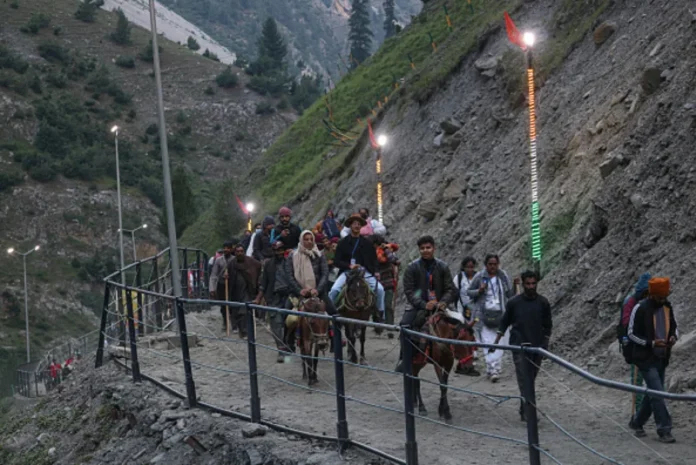Over 1.63 lakh pilgrims have undertaken the sacred Amarnath Yatra since its beginning on July 3, even as another batch of 6,639 yatris set out from Jammu for Kashmir on Saturday early.
The pilgrims who have so far undertaken the yatra have performed ‘darshan’ at the sacred cave shrine, which is located at an altitude of 3,888 meters in the Himalayas of south Kashmir, officials said. Two escorted convoys of the new batch of pilgrims left Bhagwati Nagar Yatri Niwas, Jammu, on Saturday. The first convoy of 116 vehicles carrying 2,337 yatris moved at 2:50 a.m. towards Baltal base camp. The second convoy of 161 vehicles carrying 4,302 pilgrims left at 3:55 a.m. for Nunwan base camp in Pahalgam.
Meanwhile, Bhumi Pujan of the sacred ‘Chhari Mubarak’ (Lord Shiva’s Sacred Mace) was performed at Pahalgam on Thursday. The traditional mace was taken out from the Dashnami Akhara Building in Srinagar by a procession of sadhus led by Mahant Swami Deependra Giri, the sole custodian of the Chhari Mubarak. The procession carried the mace to the Gauri Shankar temple in Pahalgam, where the traditional Bhumi Pujan was performed. The Chhari Mubarak will reach the holy cave shrine on August 9, the final day of the yatra, which also happens to be Shravan Purnima and Raksha Bandhan.
In the backdrop of heightened security threats, particularly following the April 22 terrorist attack in Pahalgam’s Baisaran meadow that left 26 dead, authorities have made enormous multi-layered security arrangements. The Union government has also deployed 180 additional companies of Central Armed Police Forces (CAPFs) to reinforce the existing deployments by the Army, BSF, CRPF, SSB, and local police.
The Indian Army has also launched a massive security operation named “Operation SHIVA 2025.” More than 8,500 troops have been deployed along with state-of-the-art surveillance and combat technology for the security of the pilgrims. The operation includes a dedicated counter-UAS (Unmanned Aerial System) grid with over 50 electronic warfare and counter-drone systems to neutralize airborne threats.
Live monitoring using UAVs (drones) and PTZ cameras is being used for the surveillance of yatra convoys and movement in the vicinity of the cave shrine. Engineer task forces have been deployed for maintenance and improvement of infrastructure along the route, like construction of bridges, widening of tracks, and landslide control.
Medical preparedness has also been reinforced significantly. The Army has sent more than 150 doctors and paramedics, two Advanced Dressing Stations, nine Medical Aid Posts, a 100-bed hospital, and 26 oxygen booths with 2 lakh liters of oxygen. Bomb detection squads, technical detachments, and communication teams have also been sent.
Transit camps, base camps, and the entire path from Jammu to the holy cave are under high surveillance and security. Surprisingly, helicopter services have been suspended this year due to security concerns.
The pilgrims undertake the yatra to behold the naturally formed ice stalagmite in the cave shrine, which is believed by the devotees to be a symbol of Lord Shiva. The formation is also believed to grow and decrease in size with the cycle of the moon, further enhancing its mystique.
The Amarnath Yatra is one of the most sacred pilgrimages of Hinduism. It is said that in this cave, Lord Shiva revealed the secrets of immortality and eternal life to Mata Parvati.
The pilgrim this year is 38 days in duration, and thousands of pilgrims are trekking along the two traditional routes: the ancient 46-kilometre Pahalgam route, which takes four days usually, and the shorter 14-kilometre Baltal route, along which pilgrims finish the round trip in a day.



